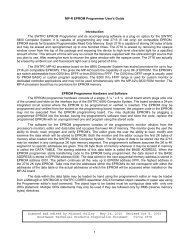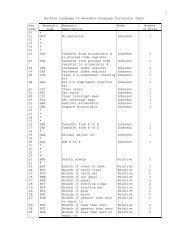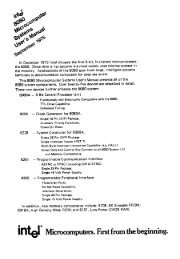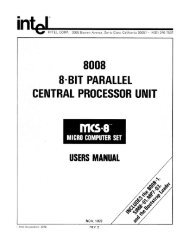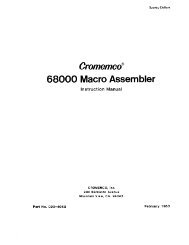The System Manual of SOL-20 - History of Computers
The System Manual of SOL-20 - History of Computers
The System Manual of SOL-20 - History of Computers
Create successful ePaper yourself
Turn your PDF publications into a flip-book with our unique Google optimized e-Paper software.
PROCESSOR TECHNOLOGY CORPORATION<br />
Sol THEORY OF OPERATION<br />
SECTION VIII<br />
following release <strong>of</strong> KEY. On the third cycle the circuit reverts to<br />
its original state.<br />
This circuit, comprised <strong>of</strong> U<strong>20</strong>, U26, U16 and U17 serves two<br />
functions. By requiring two events during two consecutive count cycles<br />
before generating a KEY, it discriminates against false key closures.<br />
It also insures that multiple key strokes are serviced in order.<br />
(This is the n-key rollover feature.) That is because the rowcolumn<br />
addresses are continuously presented to U<strong>20</strong> and this circuit's<br />
cycle can occur for each possible key closure. U<strong>20</strong> can thus contain<br />
data for all possible key closures, and the data will enter U1 and U2<br />
on the KEY generated for each closure as the row-column count progresses.<br />
<strong>The</strong> previously mentioned column 30 output on pin 4 <strong>of</strong> U17<br />
drives the keyboard control key "switches". Data for these key closures,<br />
present on pins 1, 2 and 3 <strong>of</strong> addressable latch U12 is latched<br />
in U12 during Clock 8 and φ2 when column 30 is driven. Pin 13 <strong>of</strong> U12<br />
is connected to the complement <strong>of</strong> PKD_minus_1. Thus, the data<br />
(active low) is strobed into U12 on the first count cycle. During<br />
the third count it will be strobed again and a high is read in. When<br />
the key is released, a low is strobed in again. As a result, a high<br />
active pulse appears on the output line related to the key that was<br />
closed for the duration <strong>of</strong> the key closure.<br />
SHIFT and SHIFT_LOCK, on pins 11 and 10 respectively, are<br />
applied through U23 inverter stages to NOR gates U13 and U14. <strong>The</strong>se<br />
are connected as a cross-coupled flip-flop. An active SHIFT sets<br />
this flip-flop at pin 5 <strong>of</strong> U13 to make output pin 6 <strong>of</strong> U13 and output<br />
pin 3 <strong>of</strong> U14 high. <strong>The</strong> latter is connected to pin 3 <strong>of</strong> U18, a 512 x<br />
4 bit ROM. U18 is programmed to output the high-order four bits <strong>of</strong><br />
the data to U1 according to the states <strong>of</strong> pins 1, 2 or 3.<br />
<strong>The</strong> U13-14 flip-flop is set to a high on pin 6 if SHIFT_LOCK<br />
is active. As can be seen, the shift bit to U18 is high by virtue <strong>of</strong><br />
the low on pin 6 <strong>of</strong> U13 and it will remain so until SHIFT again<br />
causes U13-14 to change state. When output pin 6 <strong>of</strong> U14 is high, pin<br />
12 <strong>of</strong> U24 is low to turn light emitting diode LED1 on. This LED is<br />
located in the SHIFT_LOCK key and indicates the keyboard is in a<br />
locked shift condition.<br />
When UPPER_CASE is active, pin 7 <strong>of</strong> U12 goes high to clock D<br />
flip-flop Ul5 on pin 3. This flip-flop is connected to operate in a<br />
toggle mode. On the UPPER_CASE "clock", pin 5 <strong>of</strong> U15 goes to make<br />
pin 2 <strong>of</strong> U18 low. <strong>The</strong> high on pin 6 <strong>of</strong> U15 is inverted by U24 to<br />
turn on LED2. LED2 is located in the UPPER CASE key. A second closure<br />
<strong>of</strong> this key toggles U15 to the opposite condition.<br />
Now assume the LOCAL key is depressed, the output on pin 5 <strong>of</strong><br />
U12 goes active high to clock the other D flip-flop U15 stage at pin<br />
11. This stage also operates as a toggle, and output pin 9 goes low<br />
to become LOCAL on pin 14 <strong>of</strong> J1. Again, the high on output pin 8<br />
VIII-44



